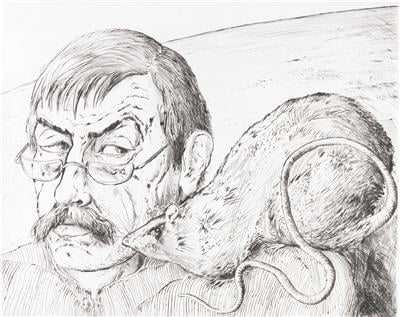German novelist and 1999 Nobel Prize winner Günter Grass died on April 13 in Lübeck at the age of 87. According to an obituary in the New York Times, Grass was hospitalized after quickly falling ill. However, the official cause of death has yet to be revealed.
Grass is best known for his first novel, The Tin Drum, and his left-wing social criticism (many referred to him as Germany’s moral conscience), but he also inspired outrage when he revealed in 2006 that toward the end of World War II, he had been conscripted into the SS.
Lesser known about the controversial figure is that he also dabbled in sculpture, drawing, printmaking, and graphic design.
“With drawing, I am acutely aware of creating something on a sheet of paper,” Grass told the Paris Review in a 1992 interview. “It is a sensual act, which you cannot say about the act of writing. In fact, I often turn to drawing to recover from the writing.”
As a young man, before turning to literature, Grass studied sculpture at the Kunstakademie Düsseldorf (see Over 60 Artworks Trashed at Kunstakademie Düsseldorf). He later became a founding member of Group 47, a literary association whose goal was to inform the German public about democracy in the wake of the Hitler era.
He returned to visual art later in his life, after enjoying a career as a prominent writer and activist. In the mid-1980s, he and his wife moved to a remote town outside of Lübeck where he sculpted and drew. His sculptures were cast in bronze by a foundry in Munich and, according to the artnet Price Database, have sold at auction on numerous occasions.
“Günter Grass has achieved a very rare thing in contemporary arts and letters, earning both critical respect and commercial success in every genre and artistic medium he has taken up,” wrote Elizabeth Gaffney in the Paris Review.
In 2002, the Günter Grass House opened in Lübeck as a forum for both literature and the visual arts in the same building where Grass maintained an office. The interdisciplinary research museum has a collection of over 1,100 drawings, lithographs, paintings, etchings, and manuscripts, and has held solo exhibitions of work by Hermann Hesse, John Lennon (see Beatles Sold! John Lennon Manuscripts Score $3 Million, Hope Defines Julian Lennon’s Eerily Beautiful Photographs at Emmanuel Fremin), Johann Wolfgang von Goethe, and Robert Gernhardt.
Grass came under fire for admitting that he had been a member of the Waffen-SS in World War II. “It happened as it did to many of my age. We were in the labour service and all at once, a year later, the call-up notice lay on the table. And only when I got to Dresden did I learn it was the Waffen-SS,” he told BBC. Due to his status as a moral authority within Germany, many fans felt strongly betrayed by this revelation.
Apart from creating his own work, the novelist and artist was also an inspiration to other visual artists. Swiss-German artist Dieter Roth used pages from The Tin Drum in one of his “Literaturewurst” sculptures, which he began creating in the 1960s. The main subject of the famed novel, the young drummer boy, was further referenced by Maurizio Cattelan (see Take a Peek at Art World Prankster Maurizio Cattelan’s Documentary) in his 2003 Untitled sculpture of a young boy playing a drum, which is in the Menil Collection and has been interpreted by some as a call to arms.
